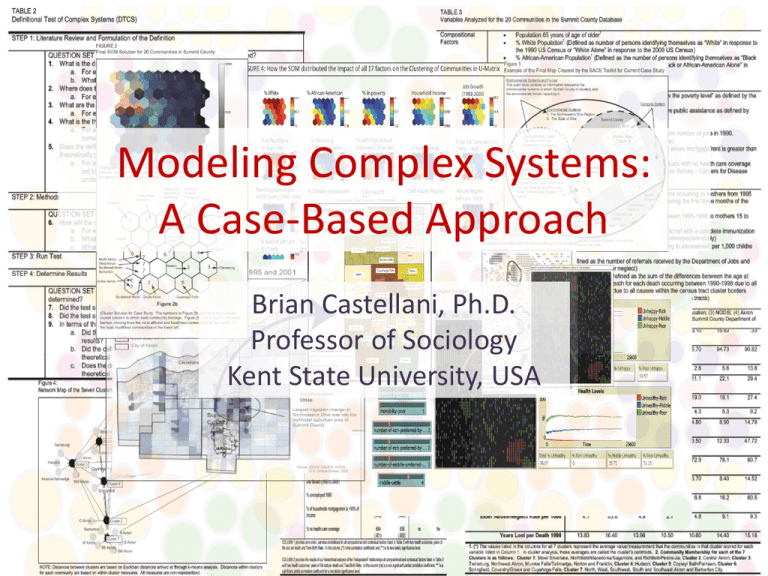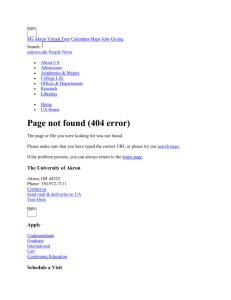Modeling Complex Systems: A Case-Based Approach Brian Castellani, Ph.D. Professor of Sociology
advertisement

Modeling Complex Systems: A Case-Based Approach Brian Castellani, Ph.D. Professor of Sociology Kent State University, USA • Over the past several years we have developed a case-based, mixed-methods, density approach to modeling the temporal and spatial complexities of big data. • The platform for this approach is called the SACS Toolkit. In terms of simplifying assumptions, the Toolkit employs three novel solutions: • (1) it conceptualizes the complex causal organization of a system as a set of microscopic cases (k-dimensional vectors spaces); • (2) it clusters/groups cases to identify major and minor profiles and (discrete or continuous) trajectories • (3) it translates their high-dynamic microscopic trajectories into the movement of macroscopic, low-dynamic densities. • The strengths of this approach are several. It allows researchers to: • Model complex systems as sets of cases. • Explore these systems at multiple levels. • Examine the interactions between system and environment. • Explore the relationships amongst the cases (networks). • Address and combine both structure (organizational pattern) and agency. • Study complex causal structure. • Use small to big data. • Model these systems as static or longitudinal. • In terms of longitudinal, we can model as discrete or continuous • In terms of continuous modeling, we can: • map the complex, nonlinear evolution of ensembles (or densities) of cases; • classify major and minor clusters and time-trends; • visually identify dynamical states, such as saddles and attractor points; • plot the speed of cases along different states; • detect the non-equilibrium clustering of case trajectories during key transient times; • construct multiple models to fit novel data; • predict future time-trends and dynamical states; and, finally, in terms of impact, • generate results that are visually and conceptually intuitive to private/public sector users and policy makers. Cases Are Complex Systems • Researchers in the social sciences currently employ a variety of mathematical/ computational models for studying complex systems. • Despite the diversity of these models, the majority can be grouped into one of four types: – equation-based modeling, – stochastic (statistical) modeling, – computational modeling – network modeling. • However, David Byrne and colleagues have added a fifth type: case-based modeling Cases Are Complex Systems • Byrne is recognized, internationally, as a leading figure in what most scholars see as two highly promising but distinct fields of study: – (1) case-based method and – (2) the sociological study of complex systems. – An example of the former is Byrne's Sage Handbook of Case-Based Methods – which he coedited with Charles Ragin, the creator of Qualitative Comparative Analysis. – An example of the latter is his widely read Complexity Theory and the Social Sciences – which Callaghan and he just significantly updated in 2013. Cases Are Complex Systems • What scholars (including the current authors) are only beginning to grasp, however, is that Byrne sees these areas as conditional upon one another – that is, they are two sides of the same theoretical/methodological coin: • His premise, while simple enough, is ground-breaking: – Cases are the methodological equivalent of complex systems; or, alternatively, complex systems are, theoretically speaking, cases and therefore should be studied as such. • With this premise – Byrne introduces an entirely new approach for modeling social complexity and the temporal and spatial dynamics of complex systems. Cases Are Complex Systems • There are several strengths to this approach, three of which are crucial to the work Dr. Rajaram and I are doing: 1. It embraces an interdisciplinary framework –with great thought given to the transport of theories, concepts, and methods between scientific and disciplinary boundaries, for the purposes of modeling social complexity and complex social systems. 2. It employs a mixed-methods toolkit, including casecomparative analysis and many of the latest advances in computational and complexity science method. 3. It provides an epistemological platform (grounded in complex realism) for constructing a cohesive ‘complex systems’ methodology, based on its concept of the case. Cases Are Complex Systems • Pace Byrne, we seek to develop a mathematically-rigorous, computationallybased, mixed-methods platform for modeling social complexity and complex social systems. • The purpose of this presentation (in combination with that of Dr. Rajaram) is to explore what we have so far accomplished – albeit tentatively. Cases Are Complex Systems • To begin, we have introduced two new terms: – case-based complexity science is the attempt to actively integrate case-based method with the latest developments in the complexity and social sciences for the purpose of modeling complex social systems as sets of cases. • It also revolves around a particular set of epistemological assumptions: • Complexity theory is not so much a substantive theory, as much as it is an epistemologically explicit attempt to model social life in complex systems terms. • It also revolves around complex realism – In turn, case-based modeling is the mixed-methods set of techniques scholars use to engage in case-based complexity science, particularly the latest developments in the computational and complexity sciences. • The key to this approach is that the methods serve the purpose of case-comparative analysis, from small to big data! Cases Are Complex Systems • We also introduce a new methodological framework: the Sociology and Complexity Science (SACS) Toolkit. • The SACS Toolkit is a the case-based, mixedmethods, computationally-grounded platform for modeling socio-biological complexity and, more specifically, complex socio-biological systems. SACS Toolkit SACS Toolkit SACS Toolkit SACS Toolkit SACS Toolkit SACS Toolkit Simplifying Assumptions Clustering and grouping to search for major and minor configurations/ profiles and trajectories (discrete or continuous) TABLE 3 Final K-means Cluster Solution for 20 Communities in Summit County Variables (Unless otherwise noted, all data is from 1990—See Table 2) Cluster 1 2 3 4 5 6 7 % Non-Hispanic Caucasian 97.3* 68.6 93.5 97.6 93.8 98.4 77.5 % African-American 1.7 28.0 5.6 1.0 4.7 1.0 21.2 % Overall Poverty 3.60 44.30 6.04 1.00 2.60 6.77 19.30 1990 household Income 41464 11404 36021 68083 49144 30002 21688 Job Growth (1993 to 2000) 31.87 20.80 17.36 27.70 43.10 15.83 .33 % Civilian Labor Force (16+ old) 96.17 85.90 95.22 96.60 95.70 94.73 90.82 % Receiving Public Assistance % No High School Degree (25yrs+) 2.8 15.3 25.8 41.5 4.3 16.8 1.4 2.7 2.6 11.1 5.6 22.1 13.8 29.4 % of households mortgage/rent is <30% of income 16.0 43.4 17.6 15.8 19.0 18.1 27.4 % Unemployed % No 1st Trimester Care 1995-98 3.8 5.63 14.1 24.60 4.8 7.54 3.4 1.20 4.3 4.80 5.3 8.90 9.2 14.78 Teen Pregnancies per 1000 births (1995-1998) 5.80 66.00 12.54 1.30 3.50 12.33 47.72 % children immunized by 2yrs of age 74.1 40.0 76.5 86.1 72.9 78.1 60.7 % No Health Care Coverage 4.20 25.30 6.34 1.20 3.70 8.40 14.52 Child Abuse/Neglect Rate per 1000 10.8 98.3 19.3 4.0 6.8 16.2 60.5 Elder Abuse/Neglect Rate per 1000 4.1 53.8 4.9 2.1 4.8 9.1 9.3 Years Lost per Death 1998 13.83 16.40 13.96 10.50 10.60 14.40 15.18 1. (*) The values listed in the columns for all 7 clusters represent the average value/measurement that the communities in that cluster scored for each variable listed in Column 1. In cluster analysis, these averages are called the cluster’s centroids. 2. Community Membership for each of the 7 Clusters is as follows: Cluster 1: Stow/ Silverlake, Northfield/Macedonia/Sagamore, and Richfield/Peninsula; Cluster 2: Central Akron; Cluster 3: Twinsburg, Northwest Akron, Munroe Falls/Tallmadge, Norton and Franklin; Cluster 4: Hudson; Cluster 5: Copley/ Bath/Fairlawn; Cluster 6: Springfield, Coventry/Green and Cuyahoga Falls; Cluster 7: North, West, Southwest, South and Southeast Akron and Barberton City. How did things change between 1990 and 2000? Richfield/Boston/ Peninsula D=1538 Coventry/Green D=387 Stow/Silver Lake D=1538 Springfield D=3366 North Akron D=1449 NW Akron D=1956 Barberton D=53 SW Akron D=2648 Franklin D=1254 Norton D=582 Twinsburg D=225 South Akron D=2218 SE Akron D=542 Hudson D=00 C 7 C 6 West Akron D=1277 C 4 C 5 C 1 C 2 Cuyahoga Falls D=2784 Copley/Bath/ Fairlawn D=00 Sagamore/Macedonia/ Northfield D=888 C 3 Munroe Falls/ Tallmadge D=2823 Distances between Final Cluster Centers Central Akron D=2648 Cluster 1 2 3 4 5 6 7 1 19776.658 4642.821 26619.008 7680.005 11462.011 30060.373 2 19776.658 15133.847 46395.596 27456.630 8314.774 10283.802 3 4642.821 15133.847 31261.814 12322.816 6819.205 25417.577 4 26619.008 46395.596 31261.814 18939.008 38081.013 56679.240 5 7680.005 27456.630 12322.816 18939.008 19142.012 37740.317 6 11462.011 8314.774 6819.205 38081.013 19142.012 7 30060.373 10283.802 25417.577 56679.240 37740.317 18598.509 18598.509 Network of Attracting Clusters Yr = 1990 (Within and Between Euclidian Distance Measures) How did things change between 1990 and 2000? Sagamore/Macedonia/ Northfield D=888 Copley/Bath/ Fairlawn D=1538 Twinsburg D=225 Stow/Silver Lake D=1538 Norton D=582 C 5 C 1 Cuyahoga Falls D=2784 Springfield D=3366 Hudson D=00 Franklin D=1254 North Akron D=1449 West Akron D=1277 Richfield/Boston/ Peninsula D=1538 C 2 C 6 C 7 NW Akron D=1956 C 4 Coventry/Green D=387 Munroe Falls/ Tallmadge D=2823 Distances between Final Cluster Centers South Akron D=2218 Barberton D=53 C 3 SE Akron D=542 Central Akron D=2648 SW Akron D=2648 Cluster 1 2 3 4 5 6 7 1 19798.352 41564.977 38661.671 6942.672 31165.038 12538.853 2 19798.352 21766.700 58460.010 26741.022 11366.758 7259.517 3 41565.0 21766.7 80226.6 48507.6 10400.0 29026.2 4 38661.671 58460.010 80226.593 31719.005 69826.660 51200.509 5 6942.672 26741.022 48507.635 31719.005 38107.699 19481.522 6 31165.038 11366.758 10399.992 69826.660 38107.699 7 12538.853 7259.517 29026.165 51200.509 19481.522 18626.213 18626.213 Network of Attracting Clusters Yr = 2000 (Within and Between Euclidian Distance Measures)

